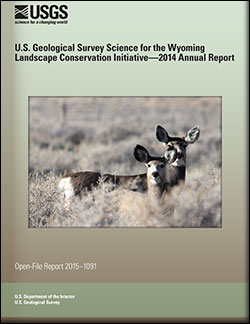|
|

The rapid expansion of natural gas development in Southwest Wyoming has raised concerns about how that development affects key wildlife species and habitats. The overall goal of this project is to determine how the presence and intensity of oil and natural gas development are affecting habitat and water quality, and how they, in turn, can influence the presence and abundance of native fish species. The project addresses the WLCI management needs to identify the condition and distribution of key wildlife species and habitats, and species habitat requirements, and to evaluate wildlife and livestock responses to development. Our approach is a comparative study examining subwatersheds affected by different levels of...
|

Surface-water availability has been identified as one of the biggest issues facing society in the 21st century. Where and when water is on the landscape can have profound impacts on the economy, wildlife behavior, recreational use, industrial practices, energy development, and many other aspects of life, society, and the environment. Projections indicate that surface-water availability will be generally reduced in the future because of multiple factors including climate change, increased drought frequency and severity, and altered water and land use. Thus, it is important resource managers understand which areas are most vulnerable to reduced water availability impacts, and to what extent current conditions may...
Categories: Project;
Types: Map Service,
OGC WFS Layer,
OGC WMS Layer,
OGC WMS Service;
Tags: 2022,
CASC,
Data Visualization & Tools,
Data Visualization & Tools,
Drought, Fire and Extreme Weather, All tags...
Mammals,
Mammals,
North Central,
North Central CASC,
Northwest,
Northwest CASC,
Projects by Region,
Rivers, Streams and Lakes,
Rivers, Streams and Lakes,
Science Tools for Managers,
Science Tools for Managers,
Water, Coasts and Ice,
Water, Coasts and Ice,
Wetlands,
Wetlands,
Wildlife and Plants,
Wildlife and Plants, Fewer tags
|

The dataset includes Roundtail Chub and Flannelmouth Sucker detections at passive integrated transponder (PIT) tag antenna systems. We installed nine instream Biomark PIT-tag antenna systems (five 24-meter and four 9-meter antennas) in a pass-over orientation throughout the Blacks Fork subbasin. In addition to the fixed antennas, we used a Biomark inflatable antenna and two Biomark submersible PIT-tag antenna systems to increase detections.
|

River ecosystems support a wide diversity of biota, including thousands of fish species, which are variously adapted to the dynamic environments provided by flowing-water habitats. One of the primary ways that human activities diminish the biological capacity of rivers is by altering the natural hydrologic variability of river systems through regulation and diversion of streamflow for other uses. Managers may be able to avoid some of the worst effects of flow management on aquatic biota if we understand the mechanisms by which streamflow components, such as unusually high and low flow events, affect populations (e.g., by influencing recruitment and mortality). Numerous past studies have described correlative associations...
|

This is the seventh report produced by the U.S. Geological Survey (USGS) for the Wyoming Landscape Conservation Initiative (WLCI) to detail annual activities conducted by the USGS for addressing specific management needs identified by WLCI partners. In FY2014, there were 26 projects, including a new one that was completed, two others that were also completed, and several that entered new phases or directions. The 26 projects fall into several categories: (1) synthesizing and analyzing existing data to identify current conditions on the landscape and using the data to develop models for projecting past and future landscape conditions; (2) monitoring indicators of ecosystem conditions and the effectiveness of on-the-ground...
|
View more...
|